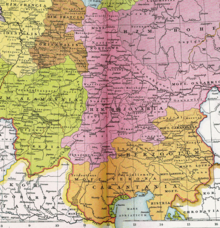Hengistburg
| Hengistburg | |
|---|---|
| Alternative name (s): | Stallion castle |
| Creation time : | around 800 |
| Conservation status: | Burgstall |
The Hengistburg , also called Hengstburg , is an abandoned castle in Central Styria .
location
The exact location of the Hengistburg is disputed among experts: O. Pickl, historian, locates it in Hengsberg , D. Kramer, archaeologist, in / near Wildon .
investment
The castle was a spacious fortification surrounded by ditches, earth walls and palisades, which, in conjunction with similar fortifications on the Dexenberg and the Spiegelkogel, was supposed to block the Laßnitz valley against incursions from the east.
history
The Hengistburg was the military and political center (probably Palatinate ) of the "Hengist" area on the central Mur (today Central Styria) as early as the late Carolingian period . It is reported that in the year 892 King Arnulf here in Hengistfeldon (Hengistfeld = Leibnitzer Feld, south of Hengsberg and the Wildoner Berg) had a meeting with the Slav prince Brazlaw von Sissek , which involved joint action against Great Moravia .
The original parish of St. Lorenzen zu Hengsberg, which stretched from the Gleinalm and Stubalm to the Mur, had its seat in the Hengistburg.
In 1053, Duke Conrad I of Bavaria was given to Emperor Heinrich III. Removed from office for high treason and had to flee to the Hungarians (King Andrew I ). With the support of Duke Welf III. of Carinthia and the Count Palatine Aribo II and his brother Boto , he invaded the young Karantanermark with the Hungarian army in 1053/54 (it was currently without leadership, because Margrave Gottfried von Pitten had been murdered in 1050 and the Traungauers were not yet firmly in the saddle ), devastated many places and conquered the Hengistburg ("... urbem quandam Hengistiburg dictam occupavit ..."). After the departure of the Hungarians, who had ravaged the castle, the destroyed church was repaired from 1054.
Around 1066, Markwart von Eppenstein and his wife Liutbirg gave their share of the church in castro Heingist to the Archbishop of Salzburg Gebhard with a noble hoof ; apparently the Hengistburg itself also came to Salzburg , because up until 1150 the archbishop's ministerials had their seat here.
At the time of Archbishop Gebhard von Salzburg (1060-88), the parents of Bishop Altmann von Trient , Count Udalschalk von Lurngau and Adelheid von Krain, traded Hengist for the property Cidlarn (Zeitlarn west of Burghausen ). (Salzb. UB.)
Before 1160, however, the castle came to Margrave Ottokar III. von Steyr, who enfeoffed his Ministerial Richer de Hengst , the ancestor of the Lords of Wildon . From 1156/60 the main base of the Mark was relocated to Graz and the castle lost its importance.
"The original parish of St. Lorenzen zu Hengsberg, however, was able to maintain its function as a church center and preserve the memory that Hengsberg had been the political-military center of the Karantanian Mark and Styria for around 200 years through the Hengistburg." ( Pickl )
Trivia
The Mark on the Mur was also called Grafschaft Hengist (Hengistgau) or Mark Hengist.
See also
Web links
- Entry on Hengistburg in the Austria Forum (in the AEIOU Austria Lexicon )
